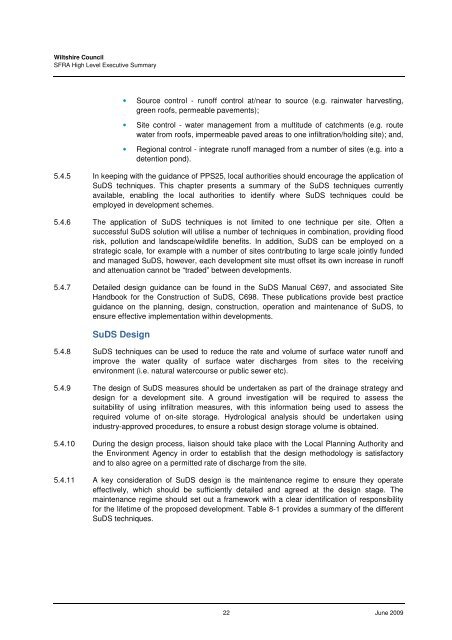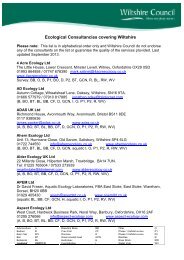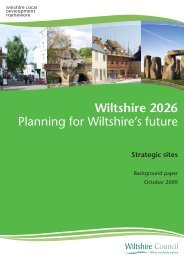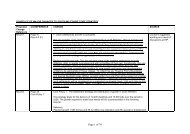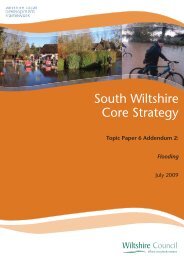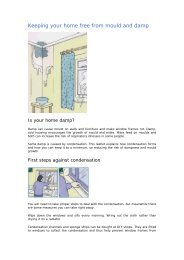Strategic Flood Risk Assessment - Wiltshire Council
Strategic Flood Risk Assessment - Wiltshire Council
Strategic Flood Risk Assessment - Wiltshire Council
You also want an ePaper? Increase the reach of your titles
YUMPU automatically turns print PDFs into web optimized ePapers that Google loves.
<strong>Wiltshire</strong> <strong>Council</strong>SFRA High Level Executive Summary• Source control - runoff control at/near to source (e.g. rainwater harvesting,green roofs, permeable pavements);• Site control - water management from a multitude of catchments (e.g. routewater from roofs, impermeable paved areas to one infiltration/holding site); and,• Regional control - integrate runoff managed from a number of sites (e.g. into adetention pond).5.4.5 In keeping with the guidance of PPS25, local authorities should encourage the application ofSuDS techniques. This chapter presents a summary of the SuDS techniques currentlyavailable, enabling the local authorities to identify where SuDS techniques could beemployed in development schemes.5.4.6 The application of SuDS techniques is not limited to one technique per site. Often asuccessful SuDS solution will utilise a number of techniques in combination, providing floodrisk, pollution and landscape/wildlife benefits. In addition, SuDS can be employed on astrategic scale, for example with a number of sites contributing to large scale jointly fundedand managed SuDS, however, each development site must offset its own increase in runoffand attenuation cannot be “traded” between developments.5.4.7 Detailed design guidance can be found in the SuDS Manual C697, and associated SiteHandbook for the Construction of SuDS, C698. These publications provide best practiceguidance on the planning, design, construction, operation and maintenance of SuDS, toensure effective implementation within developments.SuDS Design5.4.8 SuDS techniques can be used to reduce the rate and volume of surface water runoff andimprove the water quality of surface water discharges from sites to the receivingenvironment (i.e. natural watercourse or public sewer etc).5.4.9 The design of SuDS measures should be undertaken as part of the drainage strategy anddesign for a development site. A ground investigation will be required to assess thesuitability of using infiltration measures, with this information being used to assess therequired volume of on-site storage. Hydrological analysis should be undertaken usingindustry-approved procedures, to ensure a robust design storage volume is obtained.5.4.10 During the design process, liaison should take place with the Local Planning Authority andthe Environment Agency in order to establish that the design methodology is satisfactoryand to also agree on a permitted rate of discharge from the site.5.4.11 A key consideration of SuDS design is the maintenance regime to ensure they operateeffectively, which should be sufficiently detailed and agreed at the design stage. Themaintenance regime should set out a framework with a clear identification of responsibilityfor the lifetime of the proposed development. Table 8-1 provides a summary of the differentSuDS techniques.22 June 2009


